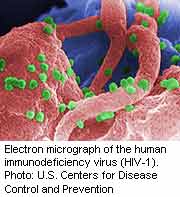
THURSDAY, June 23 (HealthDay News) — A trial HIV testing program screened nearly 2.8 million Americans from 2007 to 2010 and identified 18,432 people infected with the AIDS-causing virus, federal health officials said Thursday.
Seventy-five percent of those newly diagnosed with HIV were referred to health care, officials from the U.S. Centers for Disease Control and Prevention said.
“The goal is to test, to link to care and then to treat,” said Dr. Michael A. Kolber, director of the Comprehensive AIDS Program at the University of Miami Miller School of Medicine.
Testing is also important because once someone finds out they are infected with HIV they often change their behavior, he said.
One of the main problems with testing is reaching those groups of people most at risk, including gay and bisexual men and African Americans, who make up the majority of new cases, the CDC said. The new report said blacks accounted for 60 percent of those tested and 70 percent of the new cases.
Due to the program’s success, the CDC has extended it. The agency said that of the 1.2 million Americans living with HIV, 20 percent don’t know they are infected.
“Expanding testing is critical to help individuals receive life-extending treatment and protect the health of their partners,” the CDC said.
More HIV testing, particularly in health-care settings, can help to identify more new cases. This, in turn, can lead to earlier treatment with life-extending drugs, fewer deaths and reduced transmission of the virus, the agency said.
Said Kolber: “We know that getting people started on antiretroviral therapy has an impact on disease progression.”
He believes HIV infection should be treated like any sexually transmitted disease.
“If you are sexually active, you should be tested frequently,” he said. “If we did have it as a regular test, like any sexually transmitted disease test, we would probably pick up more people. The only way to affect an epidemic such as this is to find everybody who has the disease and try to take care of them.”
The new report is published in the June 24 issue of the CDC’s Morbidity and Mortality Weekly Report.
More information
For more on HIV/AIDS, visit AIDS.gov.

